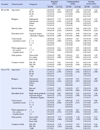Abstract
Purpose
The purpose of this study was to investigate empathy ability, communication, and nursing performance among registered nurses (RN) and nursing assistants (NA) in long-term care hospitals.
Methods
Participants were 155 nursing personnel (RN 80 and AN 75) who worked in 8 long-term care hospitals in G city and J Province. Data collection was conducted from July 6 to August 6, 2016. Descriptive statistics, independent t-test, one-way ANOVA, and stepwise multiple regression were used with SPSS/WIN program version 23.0 for data analysis.
Results
Nursing performance of RN was significantly influenced by communication ability (β=.88, p<.001) and university graduation (β=.25, p=.025). Nursing performance of NA was influential by communication ability (β=.77, p<.001) and marriage (β=.42, p=.018).
Conclusion
Findings show that communication ability of RN and NA is important in nursing performance. Therefore, there is a need to develop programs to improve communication ability and validate the effectiveness of the programs in improving nursing performance of nursing personnel working at long-term care hospitals.
Figures and Tables
References
1. Statistics Korea. 3_9 Manpower status by classification II (nurse and others) [Internet]. Daejeon: Statistics Korea;2016. cited 2016 May 22. Available from: http://kosis.kr/statHtml/statHtml.do?orgId=354&tblId=DT_HIRA4A&vw_cd=MT_ZTITLE&list_id=354_MT_DTITLE&seqNo=&lang_mode=ko&language=kor&obj_var_id=&itm_id=&conn_path=E1.
2. Kim D, Lee H. Effects of long-term care hospital staff mixing level after implementing differentiated inpatient nursing fees by staffing grades. J Korean Acad Nurs Adm. 2014; 20(1):95–105. DOI: 10.11111/jkana.2014.20.1.95.
3. Oh SY. Community through empathy. Paju: Bobmunsa;2016. p. 18.
4. Lee HS, Brennan PF, Daly BJ. Relationship of empathy to appraisal, depression, life satisfaction, and physical health in informal caregivers of older adults. Res Nurs Health. 2001; 24(1):44–56. DOI: 10.1002/1098-240X(200102)24:1<44::AID-NUR1006>3.0.CO;2-S.
5. Lee JH, Cho YA. The mediating effects of empathy in the relationships between adult attachment and interpersonal competence. Korean J Couns. 2014; 15(2):579–594.
6. Yang SY. The study on relationship between empathy, ego resilience, and clinical competence of the nursing students. J Korean Data Anal Soc. 2015; 17(3):1699–1710.
7. Kim H, Yi M. Factors influencing empathy in nursing students in Korea. J Korean Acad Soc Nurs Educ. 2015; 21(2):237–245. DOI: 10.5977/jkasne.2015.21.2.237.
8. Trevizan MA, dos Santos Almeida RG, Souza MC, Mazzo A, Mendes IAC, Martins JCA. Empathy in Brazilian nursing professionals: A descriptive study. Nurs Ethics. 2015; 22(3):367–376. DOI: 10.1177/0969733014534872.
9. Dobbs D, Baker T, Carrion IV, Vongxaiburana E, Hyer K. Certified nursing assistants' perspectives of nursing home residents' pain experience: Communication patterns, cultural context, and the role of empathy. Pain Manag Nurs. 2014; 15(1):87–96. DOI: 10.1016/j.pmn.2012.06.008.
10. Lee YB, Koh MS. The effect of clinical nurses' communication competency and emotional intelligence on organizational performance. J Korean Clin Nurs Res. 2015; 21(3):347–354.
11. Korean Accreditation Board of Nursing Education. Standard book for accreditation board of nursing education [Internet]. Seoul: Korean Accreditation Board of Nursing Education;2016. cited 2016 June 14. Available from: http://www.kabone.or.kr/kabon02/index04.
12. Daedong aid nurses institute. Curriculum [Internet]. Busan: Daedong aid nurses institute;2006. cited 2016 June 14. Available from: http://www.ddcare.co.kr/page/sub2_5.
13. Kim Y, Lee ES, Choi EY. Perception of patient safety culture of hospital nurses. Korean J Hosp Manag. 2013; 18(3):27–42.
14. Im SI, Park J, Kim HS. The effects of nurse's communication and self-leadership on nursing performance. Korean J Occup Health Nurs. 2012; 21(3):274–282. DOI: 10.5807/kjohn.2012.21.3.274.
15. Ko UK, Lee TW, Lim JY. Development of a Performance Measurement Scale for hospital nurses. J Korean Acad Nurs. 2007; 37(3):286–294. DOI: 10.4040/jkan.2007.37.3.286.
16. Cho YM, Choi MS. Effect of clinical nurses' basic psychological need, self-leadership and job stress on nursing performance. J Digit Converg. 2016; 14(8):343–353. DOI: 10.14000/JDC.2016.14.8.343.
17. Ha NS, Choi J. An analysis of nursing competency affecting on job satisfaction and nursing performance among clinical nurses. J Korean Acad Nurs Adm. 2010; 16(3):286–294. DOI: 10.11111/jkana.2010.16.3.286.
18. Son YJ, Lee YA, Sim KN, Kong SS, Park YS. Influence of communication competence and burnout on nursing performance of intensive care units nurses. J Korean Acad Fundam Nurs. 2013; 20(3):278–289. DOI: 10.7739/jkafn.2013.20.3.278.
19. Song MS. The relationships between the empowerment, using performance, job satisfaction and turnover intention of long-term care hospital nurses. J Korea Acad Ind Coop Soc. 2013; 14(5):2304–2314. DOI: 10.5762/KAIS.2013.14.5.2304.
20. Sim MR, Kim KH. Job satisfaction, self-esteem, and nursing task performance among registered nurses and nurse assistants in long-term care hospitals. J Korean Acad Nurs Adm. 2010; 16(4):446–454. DOI: 10.11111/jkana.2010.16.4.446.
21. Limbu YB, Jayachandrean C, Babin BJ, Peterson RT. Empathy, nonverbal immediacy, and salesperson performance: the mediating role of adaptive selling behavior. J Bus Ind Mark. 2016; 31(5):654–667. DOI: 10.1108/JBIM-03-2015-0048.
22. Davis MH. A multidimensional approach to individual difference in empathy. JSAS Cat Sel Doc Psychol. 1980; 10:P85.
23. Kang I, Kee S, Kim SE, Jeong B, Hwang JH, Song JE, Kim JW. Reliability and Validity of the Korean-Version of Interpersonal Reactivity Index. J Korean Neuropsychiatr Assoc. 2009; 48:352–358.
24. Hur GH. Construction and validation of a Global Interpersonal Communication Competence Scale. Korean J Journal Commun Stud. 2003; 47(6):380–408.
25. Guan R, Jin L, Qian M. Validation of the Empathy Quotient-Short Form among Chinese healthcare professionals. Soc Behav Pers. 2012; 40(1):75–84. DOI: 10.2224/sbp.2012.40.1.75.
26. Hoffman ML. Development of prosocial motivation: Empathy and guilt. Dev Prosocial Behav. 1982; 281–313. DOI: 10.1016/B978-0-12-234980-5.50016-X.
27. Lee KJ, Park HJ, Kim SS. A comparative study on the counseling self-efficacy and empathy of psychiatric nurses and general ward nurses. Nurs Sci. 2014; 26(1):9–19.
28. Noh GM, Yoo MS. Effects of workplace spirituality and organizational citizenship behavior on nursing performance. J Korean Acad Nurs Adm. 2016; 22(3):251–259. DOI: 10.11111/jkana.2016.22.3.251.
29. Cho MH, Kim KH. Perceptions of adequacy and job performance of nurse assistant nursing jobs according to registered nurses and nurse assistants in geriatric hospitals, and caregivers. J Korean Acad Nurs Adm. 2016; 22(4):384–395. DOI: 10.11111/jkana.2016.22.4.384.
30. Lee HS, Kim JK. Relationship among communication competence, communication types, and organizational commitment in hospital nurses. J Korean Acad Nurs Adm. 2010; 16(4):488–496. DOI: 10.11111/jkana.2010.16.4.488.




 PDF
PDF ePub
ePub Citation
Citation Print
Print







 XML Download
XML Download